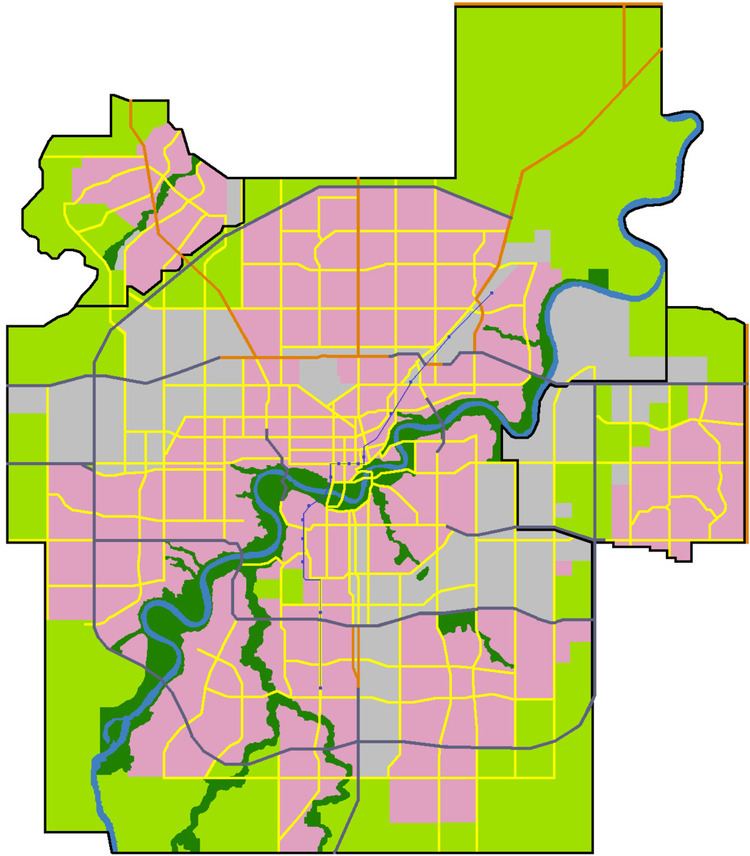Phone +1 780-496-2950 | Province Alberta | |
 | ||
Address 10125 97 Ave NW, Edmonton, AB T5K 0B3, Canada Hours Closed today SundayClosedMonday8:30AM–4:30PMTuesday8:30AM–4:30PMWednesday8:30AM–4:30PMThursday8:30AM–4:30PMFriday8:30AM–4:30PMSaturdayClosed Similar Muttart Conservatory, Fort Edmonton Park, William Hawrelak Park, Edmonton City Hall, Edmonton Valley Zoo | ||
North saskatchewan river valley parks system top 8 facts
The North Saskatchewan River valley parks system (Also known as River Valley Parks; and Ribbon of Green) is a continuous collection of urban parks in the North Saskatchewan River valley of Edmonton, Alberta.
Contents
- North saskatchewan river valley parks system top 8 facts
- North saskatchewan river valley parks system
- Parks and facilities
- Wildlife
- Politics and planning
- References
Edmonton's river valley comprises over 20 major parks and attractions and forms the largest expanses of urban parkland in Canada. The public river valley parks provide a unique urban escape area with park styles ranging from fully serviced urban parks to campsite-like facilities with few amenities. At 7,400 ha (18,000 acres) in size and 48 km (30 mi) in length, the river valley parks system consists of 22 ravines, which have a combined total length of 103 km (64 mi). It also includes 11 lakes. Most of the city has bike and walking trail connections. These trails are also part of the 235 km (146 mi) Waskahegan walking trail.
Several golf courses, both public and private, are also located in the river valley. The long summer daylight hours of this northern city provide for extended play well into the evening. Golf courses and the park system become a winter recreation area during this season. Cross-country skiing and skating are popular during the long winter. Four downhill ski slopes are located in the river valley as well, two within the city and two immediately outside.
The City of Edmonton has named five parks in its river valley parks system in honour of each of "The Famous Five".
North saskatchewan river valley parks system
Parks and facilities
The largest area in the river valley is occupied by municipal parks:
The City also operates several public facilities in the river valley:
The provincial government owns the following sites in the river valley:
Hiking, cycling, and multi-use trails run throughout these parks and connect to other trails through the city and outside as well forming an integrated system. The river valley parks in particular are part of the Waskahegan and Trans Canada trail systems.
Wildlife
Edmonton's river valley park system is home to porcupines, deer, coyotes, skunks, muskrats, rabbits, and beavers.
Edmonton's streets and parklands are also home to one of the largest remaining concentrations of healthy American Elm trees in the world, unaffected by Dutch Elm disease, which has wiped out vast numbers of such trees in eastern North America. Jack Pine, Lodgepole Pine, White Spruce, White Birch, Aspen, Green Ash, Basswood, various poplars and willows, and Manitoba Maple are also abundant; Bur Oak is increasingly popular. Introduced tree species include Blue Spruce, Norway Maple, Red Oak, Sugar Maple, Common Horse-chestnut, McIntosh Apple, and Evans Cherry. Three walnut species -- Butternut, Manchurian Walnut and Black Walnut—have survived in Edmonton.
Politics and planning
The idea of uniting the parks of the river valley into one parks system dates back to at least the 1970s. In 1974, Alberta Premier Peter Lougheed announced the creation of the Capital City Recreation Park, consisting of a 14.5-kilometre (9.0 mi) stretch of parks from the Legislature grounds east to the Beverly Bridge at an estimated cost of $30–35 million.
The River Valley Alliance is a grouping of municipal governments in the Edmonton region that have committed to expanding the River Valley Parks System outside of Edmonton's city limits. The plan calls for a 18,000-acre (73 km2) zone to be called the Capital Region Valley Park stretched over 88 kilometres running from Devon to Fort Saskatchewan.
In January 2008, the City of Edmonton paid a record C$7 million to buy a parcel of land to fill in a gap in the otherwise continuous chain of parks. The city further promised to spend C$20 million of pedestrian bridges and trails, but said that the as yet unnamed park would be left in an undeveloped state.
